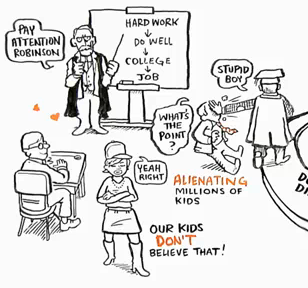What is the Hidden Curriculum?
Have you ever wondered why some schools seem to produce students who excel in standardized tests, while others seem to foster a more well-rounded, independent spirit? There’s a powerful and often hidden aspect of education that might hold the answer: the hidden curriculum. This concept recognizes that education goes beyond the official, written curriculum – the textbooks, lesson plans, and exams. The hidden curriculum comprises the unspoken rules, values, behaviors, and attitudes that students learn, often subconsciously, in the school environment.

Image: www.vtomb.com
While the official curriculum lays out the academic content, the hidden curriculum shapes students’ social, emotional, and even intellectual development. Just as a child learns to share toys on the playground, they also learn unspoken norms like respecting authority, prioritizing certain subjects, and adopting specific learning styles. This intricate system of unwritten rules and expectations can profoundly impact students’ perspectives on education, themselves, and the world.
Examples of the Hidden Curriculum in Action
1. Classroom Management and Discipline
The way a teacher manages their classroom directly influences the hidden curriculum. A teacher who emphasizes strict rules and quick punishments might teach students to value obedience and fear of authority. In contrast, a teacher who fosters collaboration and independent thinking might instill in their students a sense of responsibility and initiative.
2. The Importance of Competition
The competitive nature of many classrooms can also influence students’ learning experiences. When success is measured against peers, students learn to prioritize grades and individual achievement. This focus on competition can sometimes overshadow the importance of collaboration and mutual learning.

Image: danacpr1.weebly.com
3. The Influence of School Culture
School culture plays a vital role in shaping the hidden curriculum. A school that prioritizes athletics may subtly convey the message that athletic success is more valuable than academic achievement. Similarly, a school with a strong focus on community involvement might teach students the value of social responsibility and teamwork.
4. Unwritten Rules of Social Interaction
The unspoken rules of social interaction in schools, like who sits at which lunch table or which clubs are considered “cool,” contribute significantly to the hidden curriculum. These social norms can shape students’ self-esteem, their sense of belonging, and their willingness to challenge the status quo.
5. The Role of Technology
The increasing use of technology in education also contributes to the hidden curriculum. How technology is used in the classroom, whether for collaborative projects or simply for delivering information, influences students’ attitudes toward learning and their understanding of its relevance in the real world.
Impact of the Hidden Curriculum
The hidden curriculum can have a profound impact on student outcomes. It can:
- Reinforce or challenge societal norms: Schools can either perpetuate or challenge societal expectations about gender roles, social class, or cultural identities.
- Influence future career choices: Students learn implicit messages about the value of different professions and industries, potentially influencing their career aspirations.
- Shape students’ social and emotional development: The hidden curriculum can foster collaboration, empathy, critical thinking, or conversely, competition, conformity, and fear of failure.
- Impact academic achievement: Students may be more engaged and successful in environments that align with their learning styles and preferences.
- Contribute to inequities in education: The hidden curriculum can perpetuate systemic biases that disadvantage certain groups of students, such as students from marginalized communities or students with disabilities.
Addressing the Hidden Curriculum
Recognizing the hidden curriculum’s influence is the first step towards addressing its potential drawbacks.
- Open dialogue and awareness: Teachers and administrators should engage in open discussions about the hidden curriculum and its impact on students.
- Curriculum evaluation and revision: Regularly review and revise the curriculum to ensure that it reflects the values and goals of the school community.
- Promote diversity and inclusion: Encourage diverse perspectives and create opportunities for students to develop social and emotional skills through activities like community service, conflict resolution, and social justice initiatives.
- Encourage critical thinking: Facilitate opportunities for students to analyze and critique the unspoken rules they encounter in the school environment, encouraging critical thinking and questioning established norms.
FAQs:
Q: How can I identify the hidden curriculum in my child’s school?
Pay attention to the unspoken rules, behaviors, and values that seem to be prevalent in the school environment. Observe how teachers interact with students, how students interact with each other, and what messages are conveyed through the school’s structure, policies, and activities.
Q: Can the hidden curriculum be positive?
Yes, the hidden curriculum can have positive effects. It can foster a sense of community, promote values like respect, responsibility, and kindness, and equip students with essential social and emotional skills.
Q: What can parents do to address the hidden curriculum?
Parents can engage in open communication with their children about their experiences in school. They can also advocate for changes in school policies and practices that reinforce positive values and promote equity.
Examples Of The Hidden Curriculum
Conclusion
The hidden curriculum is a powerful force in shaping young minds, and recognizing its influence is crucial for creating a more inclusive and equitable educational system. By being mindful of the unspoken messages and norms that students learn, educators and parents can work together to foster positive social and emotional development, ensuring that all students feel valued, respected, and empowered to succeed.
Are you interested in learning more about the hidden curriculum in your community? Share your thoughts and experiences in the comments section below.






